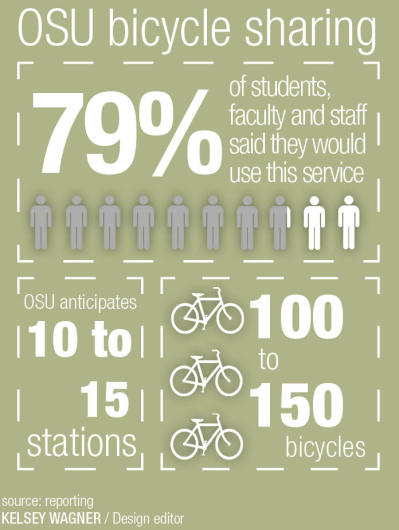Ohio State and Undergraduate Student Government are looking to bring a bike-sharing service to campus.
As part of the organizations’ joint bike-sharing initiative, seven companies were asked to participate in a bidding process that aims to determine the best fit for campus. This bidding process is set to end Friday.
“The university anticipates an initial launch to include 10 to 15 stations with 100 to 150 bicycles,” Administration and Planning spokesman Dan Hedman said in an email.
USG President Celia Wright said the idea of establishing a bike-sharing option on campus was something she and Vice President Leah Lacure incorporated into their 2014 USG campaign.
“It was something many students rallied behind through the campaign season,” Wright, a fourth-year in public health, said.
One of the companies OSU asked for a proposal was Motivate, which operates the CoGo Bike Share system in downtown Columbus.
CoGo did not respond to multiple requests for comment regarding the current bidding process.
CoGo operates 30 stations across the city and offers a 24-hour pass for $6 or an annual membership for $75. The system requires bikes to be returned to a station every 30 minutes. Additional minutes cost $3 per 30 minute time period, according to the CoGo website.
“CoGo isn’t a necessity, but it would definitely facilitate travel downtown,” Wright said. “CoGo hasn’t been jumping on that as much as I had expected them to.”
Hedman said as of now, though, no company is favored over the others.
“There are no leading candidates,” he said.
Wright said she appreciates that the university is weighing the option of incorporating a bike-sharing service between several companies.
An April survey of students, faculty and staff found that 79 percent of respondents would use a bicycle-sharing service, Hedman said.
Hedman did not give a prospective cost for the service, but said that the system “is expected to be supported through user fees.”
Wright said she would prefer that all students were automatically enrolled through their BuckIDs and had the opportunity to opt out.
“I would like the system to be compatible with the BuckID,” Wright said, but added that this is not listed as a requirement on the request for proposals.
David Lin, a second-year in electrical and computer engineering, said he does not think he would use the bike-sharing system on a day-to-day basis, but would use it if he had large distances to cover or if he needed to get somewhere quickly.
“An hourly or daily rate would be best (in order to) pay for how much I’d actually use it,” Lin said.
Hedman said the service would reinforce the university’s “‘park once’ philosophy, (as) the university continues to look for ways to embrace multi-model transportation and is in the process of refining the Comprehensive Transportation and Parking Plan.”
Pedestrian and cyclist traffic has increased since the university switched from quarters to semesters, and the CTPP aims to reduce vehicular traffic in pedestrian-heavy areas.
A CTPP executive summary released in August said the plan became necessary because of “growth at the Wexner Medical Center, planned relocation of Cannon Drive, increased bicycle and pedestrian traffic, construction of the North Residential District which includes second-year students living on campus, increased number of events at the Schottenstein Center and in the Athletic District.”
“A goal for the CTPP bicycle plan is to expand and create a clear and safe system for bicyclists to move through campus and connect to regional networks,” Hedman added.
Adding bike lanes was among the major topics of interest in a February “MindMixer” survey on campus, one of three online surveys conducted in 2014 to aid in the development of the CTPP, though the “largest percentage of comments relate to parking and pedestrian conflicts / safety.”
The majority of the 528 study participants were faculty and staff with an average age of 42. Additionally, 70 percent of the participants were female.
Emily Kasper, a first-year in exploration, said she would definitely use a bike-sharing system on campus, especially to go from one side of campus to the other. She added that she thinks prices for the service should be dependent on usage.
Hedman said the university would like the system to “conveniently and safely offer alternative transportation options for connectivity on campus and potentially to surrounding neighborhoods.”
Wright said she would be pleased if the company expanded from the campus area to the off-campus residence districts as well, though the campus area is the first priority.



